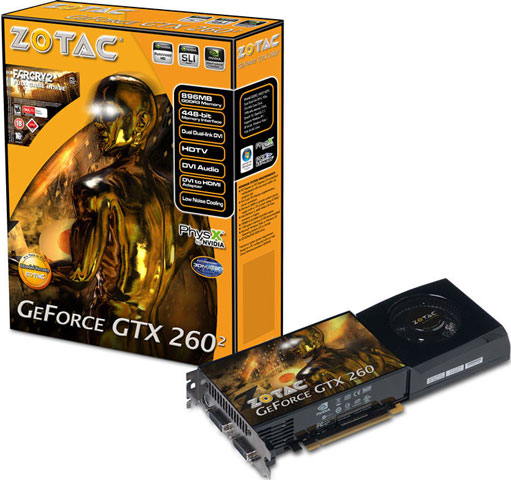GeForce GTX 260 core 216

The GT200 GPU consists of ten TPC clusters (Texture Processing Clusters) and eight wide rasterization units (ROPs) capable of outputting four pixels per clock (32 in total). Each cluster has 24 thread processors and eight TMUs each, for a total of 240 stream processors and 80 texture units, but only eight TPC clusters and seven wide ROPs were used for the GeForce GTX 260. Naturally, 192 stream processors, 64 TMUs, and 28 ROPs took a toll on performance. In addition, the GT200 chip supports 512-bit GDDR3 memory access with a total capacity of 1024 MB, but for this video card, the bus has been reduced to 448 bits, and the memory capacity is only 896 MB. Operating frequencies have also been adjusted to decrease: 576/1242 MHz and 1998 MHz versus 602/1296 MHz and 2214 MHz, chip/stream processors and memory, respectively. But this was not enough to demonstrate performance similar to the Radeon HD 4870 1GB, and the number of TPC clusters was increased to nine pieces, which gave 216 stream processors and 72 texture units operating at the same 576/1242 MHz. The frequency and memory bus remained unchanged, as did the number of ROPs.
Specifications NVIDIA GeForce GTX 260 core 216
| Name | GeForce GTX 260 core 216 |
| Core | GT200 (D10U-20) |
| Process technology (µm) | 0.065/0.055 |
| Transistors (million) | 1400 |
| Core frequency | 576 |
| Memory frequency (DDR) | 999 |
| Bus and memory type | GDDR3 448-bit |
| Bandwidth (Gb/s) | 111.89 |
| Unified shader blocks | 216 |
| Frequency of unified shader units | 1242 |
| TMU per conveyor | 72 |
| ROP | 28 |
| Shader Model | 4.0 |
| Fill Rate (Mpix/s) | 16128 |
| Fill Rate (Mtex/s) | 41472 |
| DirectX | 10 |
| Interface | PCIe 2.0 |
All in all, the new GTX 260 is brilliant and a great choice for gamers who value great speed for a reasonable price.



